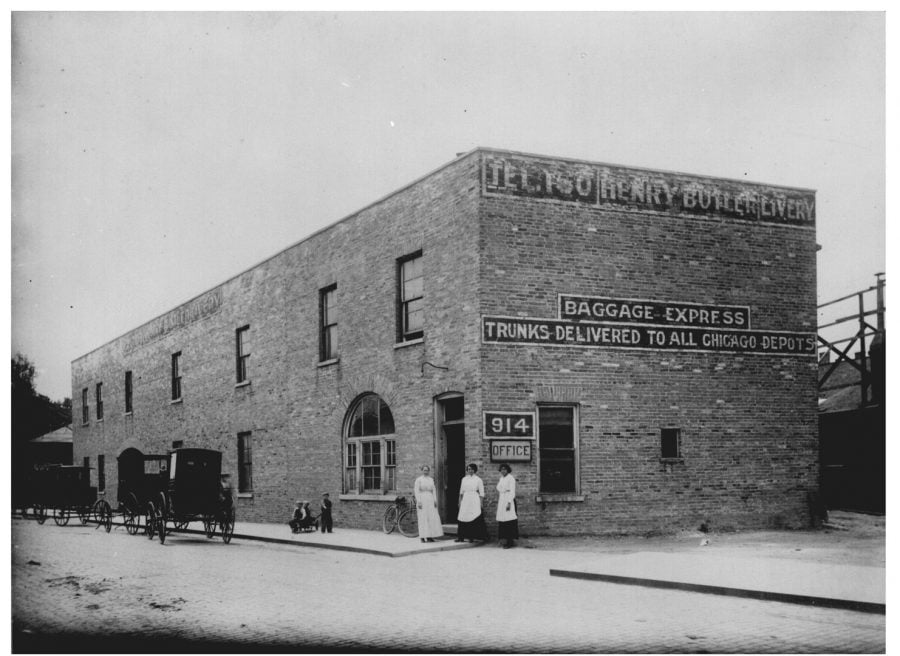Butler Livery Stable’s original location at 914 Davis St. named new African American heritage site
Courtesy of Shorefront Legacy Center
Butler Livery Stable, located at 914 Davis St., was one of Evanston’s first black-owned businesses. It is the location for one of eight new African American heritage sites in Evanston.
August 4, 2020
The entrepreneurial accomplishments of Henry Butler, one of Evanston’s first black business owners, will be honored through one of eight new African American heritage sites located throughout Evanston. The site will be located at 914 Davis St., the original location of Butler’s livery stable business.
Butler arrived in Evanston in 1882 where he was said to have “tended horses” for seven dollars a month and also worked as a butler and coachman for several families. He later opened Butler Livery Stable, a taxi, hauling and horse boarding service, with Margaret Fisher, who oversaw all the financial and secretarial aspects of the business. Together they had two livery barns, 70 teams of horses and 40 employees.
Throughout his tenure as a business owner, Butler was said to have acquired wealth in the hundred thousands and even had President William McKinley among his consumer base. Butler also owned a large blacksmith and repair shop and owned considerable real estate. He later transitioned to a cab business, which at its height had a fleet of over 200 vehicles and about 50 drivers.
However, at the turn of the 20th century, in response to Evanston’s growing black population, there was an influx of Jim Crow practices which began to control and minimize the impact of local black business ownership, according to Dino Robinson Jr., founder of the Shorefront Legacy Center.
A 1904 Chicago Tribune article entitled “North Shore Towns Aroused,” captured the cruel and racist intentions behind these practices, explicitly explaining that Evanston residents intended to segregate the black community “as a solution to the problem suddenly presented.”
Redlining and other discriminatory lending practices drove the black community and their businesses mainly into the 5th Ward, and brought about what Robinson describes as a “natural de facto segregation” between the black business community and the predominately white business scene in downtown Evanston.
Robinson said that these processes had a twofold effect: The white community was largely oblivious to black business activity in the 5th Ward, and the phrase, “we don’t go to downtown Evanston,” became a strongly enforced norm within the black community for generations.
“The black community was made outside of the black community’s control,” Robinson said. He explained that the purpose of establishing heritage sites throughout Evanston is to disseminate this fact.
However, the movement to recognize Butler’s legacy began long before the creation of these sites.
Butler’s Emerson Street location was designated as a historical landmark in the ’80s, but was torn down to make way for the Northwestern University/Evanston Research Park — a project that was never completed.
A 1989 Chicago Tribune article, “Evanston Set to Raze Landmark,” recounts the contentious history behind the demolition.
“What Henry Butler stood for represents the soul of the black community and the spirit of free enterprise in this country,” said Bennett Johnson from the Evanston/North Shore branch of the NAACP. “The black community will look at this research park as a black mark, as an attack on its integrity.”
Robinson echoed Johnson’s sentiment, mentioning that this event was part of a pattern of demolitions in Evanston where “everything that was significant to the black community was basically destroyed and discarded like it wasn’t significant.”
Members of Evanston’s black community will decide the criteria for choosing future heritage sites, Robinson noted, to ensure notable locations would not be neglected as the Butler Livery Stable once was.
“I’m just not in that mindset of waiting for somebody else to do it,” Robinson said. “I strongly believe that, especially with local black history, it is the community’s responsibility to control its own narrative.”
Email: oliviayarvis2023@u.northwestern.edu
Twitter: @oliviayarvis
Related Stories:
— Evanston Sanitarium’s original home at 1918 Asbury Ave. named new African American heritage site
— Ebenezer AME Church’s original home at 1813 Benson Ave. named new African American heritage site
— House of Edwin B. Jourdain Jr., city’s first black alderman, designated new African American heritage site



